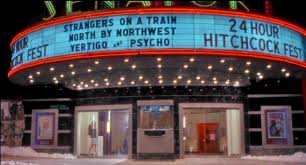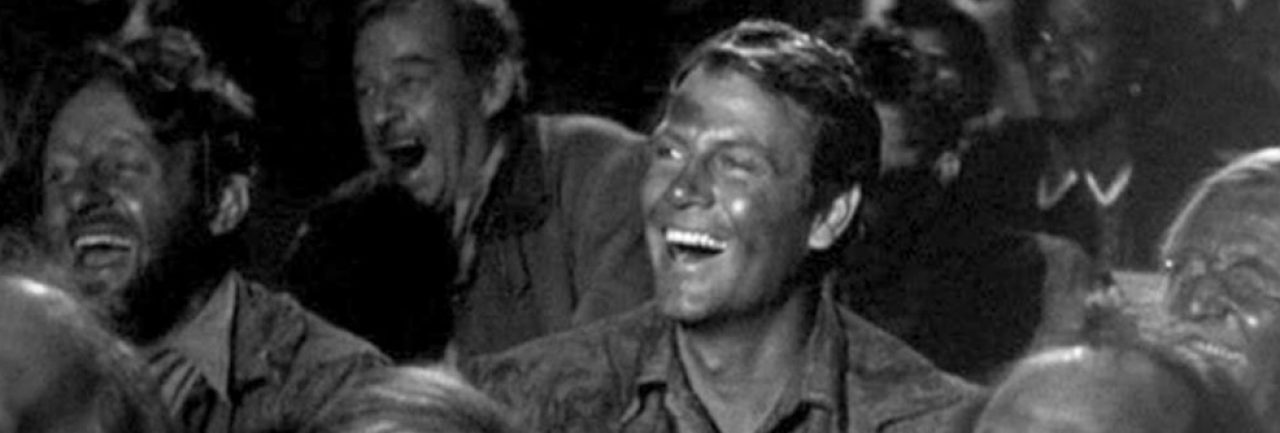
Terry Gilliam’s 1995 dystopian time-travel thriller Twelve Monkeys begins in the year 2035. We gradually learn that a virus released in 1996 killed off almost all of the world’s population. One of the underground-dwelling survivors, James Cole (Bruce Willis), is sent back in time to the 1990s to try to gather information about the outbreak. He winds up in an insane asylum, where his claims that he has come from the future don’t go over too well.
The TV-in-the-day-room is an essential fixture of such scenes, from One Flew Over the Cuckoo’s Nest on down. Often, mindless chirpy fare on the set comments on the grim reality before us. That’s the case in Twelve Monkeys, where, in addition, everything playing on the TV relates to animals. We successively see three 1940s Tex Avery cartoons: “Swing Shift Cinderella,” “Little Tinker,” and “Who Killed Who.” We also glimpse a segment from “Horizon: The Cruel Choice,” a 1983 British documentary on animal experimentation (a theme of Twelve Monkeys), which itself includes a clip from the movie The Andromeda Strain. Then, to hit the monkey theme home, the Marx Brothers’ Monkey Business briefly comes on. (It’s heard more than seen.)
In a later scene, a television is playing “Prehistoric Super Salesman,” a 1969 cartoon. IMDB’s plot description: “Woody Woodpecker is sent back to the stone age by a mad scientist and his time tunnel.”
But the big set-piece movie-in-movie scene comes late in the film, when circumstances have started to crowd in on Cole and Kathryn Railly (Madeleine Stowe), a psychiatrist he encounters in one of his visits to 1996 and who becomes his companion on the mission he comes to believe is his destiny.
The segment begins with full-screen view of a scene from Alfred Hitchcock’s Vertigo (1958) in which the characters played by Jimmy Stewart and Kim Novak are strolling among California redwoods. The dreamy Novak, who imagines herself the reincarnation of a nineteenth-century woman, points out “my” life span on an ancient tree’s rings; the parallels with Twelve Monkeys’ time traveling is clear.
We cut away to see Cole and Kathryn sitting in a Philadelphia movie theater that’s showing a 24-hour Hitchcock marathon also including (a marquee tells us) Strangers on a Train, North by Northwest, and Psycho. The parallels to Vertigo multiply. Cole say, “I think I’ve seen this movie before, when I was a kid.” And right after he says the word “before,” Stewart asks Novak (whose present-day character is named Madeleine, just like Stowe), “Have you been here before?”
Cole is mesmerized by the movie, and gets at a striking comparison: that watching a film at different times in your life might be similar to keeping on going back in time to the same moment.
It’s just like what’s happening with us. The movie never changes. It can’t change. But every time you see it, it seems different, because you’re different.
Then someone in the sparse audience shushes him, a nice touch.
The next thing Cole knows, he wakes up alone in the theater, wearing a wig and fake mustache. On the screen is yet another Hitchcock movie, The Birds, reinforcing the animals-run-amuk thread of Twelve Monkeys. He runs out to the lobby and it’s almost as if we’ve literally stepped into Vertigo. Kathryn has on a blonde wig (making her look like so many Hitchock heroines) and actually is wearing the same style of coat Novak wears in Vertigo. At the moment when Cole sees her, the soundtrack is part of Bernard Herrmann’s Vertigo score.
On the Twelve Monkeys director’s commentary, Gilliam describes how things got bizarre when he and his team looked at the scene from which they mined the music.
We discovered that the cuts between Kim and Jimmy Stewart are identical to the cuts between Madeleine and Bruce. Then it got even stranger. The scene [in Vertigo] ends when they embrace and the whole room turns around them…. The foyer of the cinema [in Twelve Monkeys] is circular. We put them on a a turntable and the whole room spins around them.
That scene was eventually cut out. Still, Gilliam says, “It was almost as if the ghost of Hitchcock was making this section of the film.”
